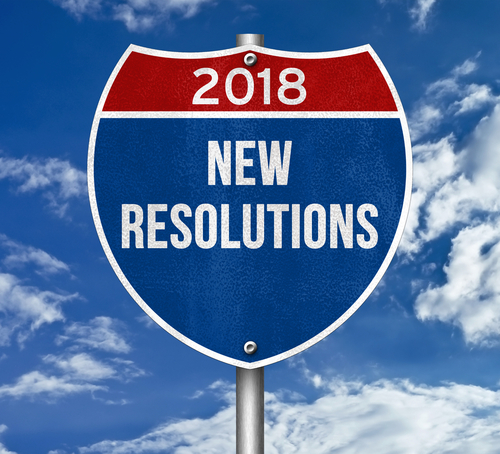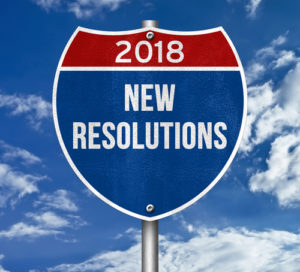
by Beth Levine | Jan 10, 2018 | preparing for a presentation, public speaking
 Resolution. noun. A firm decision to do or not to do something.
Resolution. noun. A firm decision to do or not to do something.
Exactly. A firm decision to do or not to do something is exactly what’s required when we undertake any form of self-improvement – training, coaching, even meditation or a new workout regimen. Self-improvement is simply change, and all it requires is a firm decision to do something differently.
If you’re the New Year’s Resolution type, you’ve probably made yours already. But I’d like to suggest that resolutions – or decisions to make a change – can be undertaken at any time, not just at the start of a new calendar year. While I’m a big proponent of all forms of self-improvement – personal and professional – I’m obviously mostly concerned (okay, a little obsessed) with those that can improve your communication skills.
To that end, here are 3 examples of situations that could serve as prompts to help you recognize and make resolutions to be a better communicator/presenter/speaker at any time of the year:
1. You’re in the audience listening to a speaker who just crushed their opening or closing by doing something totally outside the box. Make a note to self, jot it down (this is where taking out your cell phone during an event is warranted!). Surely, you can adapt and adopt this technique once you decide that you, too, want to be a more impactful speaker.
2. A colleague shares specific feedback she got from the CEO following a meeting. She was applauded for how she choreographed the use of visuals with discussion points to engage everyone in the room. It’s something you’ve never done before but you know is doable with some forethought and planning. Note to self: practice and then try it going forward!
3. In a presentation to a client company, you address their challenges the way you always do. You also get the same questions you always get. Take a moment to reflect and ask yourself what you can do differently to preempt these questions. What is it about your approach that is leaving the same gap in understanding each time? Make the decision to do it differently the next time and design a new approach.
It’s okay to take your inspiration for change from the examples or hints from others, we do it all the time. Think about it this way; we’ve been modeling our own behavior on the behaviors and reactions of others much longer than we’ve been making New Year’s Resolutions!

by Beth Levine | Dec 7, 2017 | preparing for a presentation, public speaking
 Given that 65% of the population are visual learners, using slides or other visual support during a presentation falls somewhere between being pretty useful and critically important. For the 65%, visual reinforcement enhances their ability to digest, process, and ultimately retain material.
Given that 65% of the population are visual learners, using slides or other visual support during a presentation falls somewhere between being pretty useful and critically important. For the 65%, visual reinforcement enhances their ability to digest, process, and ultimately retain material.
Then why is it, whenever I poll a group after speaking to them without using slides – “How many of you wish I had used PowerPoint today?” – zero hands go up. Always zero. No one misses PowerPoint.
Admittedly, I often use a white board and colorful markers to cement my key points, so I’m not eschewing visuals. And when the group I’m speaking to is large, I use PowerPoint so the slides can be projected onto a screen for everyone to see.
Generally speaking, though, people don’t like PowerPoint because it’s used poorly in many, if not most, cases. At the risk of nagging or sounding negative, here’s a top 5 list of PowerPoint “don’ts”:
1. Don’t use your slides as your presentation outline or script; they’re not for you, they’re for your audience!
2. Don’t use too many words on your slides; if your audience has a lot to read, they won’t be able to listen to you at the same time.
3. Don’t build your slides first; build your presentation outline first, complete with main points and supporting information, and then decide what kind of slides would support and reinforce them.
4. Don’t think you’re off the hook and don’t need to know/rehearse your presentation; if your your technology fails you in the room, you still have to deliver.
5. Don’t try to put everything you know in your slide deck; Microsoft named it PowerPoint, not EveryPoint.
The fact that the majority of people are visual learners underscores the importance of creating slides that are effective. At a minimum, use clean, clear graphics; memorable, relevant images; key words on text slides; and headings that tell audiences what they’re looking at and why. If you want to dig in more, there are lots of great resources available – not the least of which are Nancy Duarte’s books – to help you capture the 65% and along with them, the 35%.

by Beth Levine | Nov 14, 2017 | preparing for a presentation, public speaking
If I had a dollar for every time I told a client, “well, that’s really not what this event calls for, attendees are coming for a celebratory occasion not a lecture” or “it’s not really your place to be talking about the speaker’s topic, you’re simply introducing them” or “what you’re describing you want to talk about is more appropriate for an external audience rather than an internal one,” I could retire!
 Speakers and presenters veer out of their lanes all the time. It’s as though an invitation to make a few remarks confers responsibility for the entire event on them. Or they feel as though, given the opportunity, they need to be as comprehensive as possible. Not so.
Speakers and presenters veer out of their lanes all the time. It’s as though an invitation to make a few remarks confers responsibility for the entire event on them. Or they feel as though, given the opportunity, they need to be as comprehensive as possible. Not so.
Here are 3 tips to help you stay in your lane:
1. Know your job. For every occasion when you need to speak, you have a “job.” By job, I mean a communication task: you might need to motivate, persuade, reassure, inform, update, or even introduce. There’s always a verb that describes your job, you might even have a primary and a secondary job. Knowing your job helps you paint the boundary lines of your lane. As you prepare your remarks, all you need to do is test what you’re planning to say against your job and stay inside those boundary lines.
2. Be #audience-centric, have perspective. Have you ever been to a fundraising gala, basically a party, where everyone is dressed up, having fun, socializing at tables with friends, and then the buzzkill comes – long narratives from the microphone about the organization’s serious work (and let’s be honest here, no one’s paying attention)? Yes, the work is important and yes, there’s a captive audience; but no, now’s not the time for the laundry list of “what we do.”
Or, have you ever gone to hear a special speaker and the person who introduces them not only delivers a nice intro, but then offers their own spin or summary on the speaker’s topic? To be polite, this is not only unnecessarily repetitive but it’s also not what the audience came to hear. To be less polite, this is inappropriate, often making audience members impatient and annoyed.
Perspective is key to staying in your lane. Perspective requires you to be audience-centric – to put the audience’s needs and experience ahead of your own. Without it, you risk alienating the audience.
3. Err on the side of #brevity. When in doubt, be brief – no one has ever annoyed or alienated an audience by being brief. If you’re not sure of your job or your lane, put your energy and efforts into being short and sweet. Sometimes speakers swerve out of their lanes because they’re not clear on who is supposed to say what and they want to make sure they cover everything. I hear you, I get it. Still, either coordinate with the other presenters ahead of time and/or let your audience ask you if they need more.
At the end of the day, it’s all about them – your audience. Stay in your lane so you don’t hit them!

by Beth Levine | Oct 30, 2017 | preparing for a presentation, public speaking
I want to share a personal story that’s not entirely flattering. In fact, the episode was a little bit jolting at the time, but soon thereafter it reaffirmed two important aspects of my coaching and training philosophy:
When it comes to audiences, always connect with them and always learn from them.
So, here’s the story …
A few years back, I was invited to be the guest speaker at an open house for a Toastmasters chapter. It wasn’t a regular Toastmasters meeting, it was a membership cultivation event. I was asked to speak on the importance of having a big idea and how to identify and articulate one.
I’m a fan of Toastmasters and, in fact, recommend it to clients who need lots of practice speaking, usually to desensitize them to the fear of public speaking. The event was quite interesting, it drew a very diverse crowd of people, and the Toastmasters members and leaders were very welcoming. I gave my talk, which I had prepared ahead of time (I always prepare ahead!), I kept it brief (I always try to be brief!), and there was a robust Q&A.
 When I was done, I got great feedback and lots of thank you’s from the audience. However, on my way out the door at the end of the event, one of the chapter leaders approached me with his clipboard. Apparently, he had been scoring me while I was speaking, and it turns out I didn’t do so well by Toastmasters’s standards. He had counted um’s and ah’s (thankfully there weren’t too many), and he had timed, measured, and scrutinized me for public speaking metrics that weren’t on my radar screen.
When I was done, I got great feedback and lots of thank you’s from the audience. However, on my way out the door at the end of the event, one of the chapter leaders approached me with his clipboard. Apparently, he had been scoring me while I was speaking, and it turns out I didn’t do so well by Toastmasters’s standards. He had counted um’s and ah’s (thankfully there weren’t too many), and he had timed, measured, and scrutinized me for public speaking metrics that weren’t on my radar screen.
Admittedly, I went in unfamiliar with the methodology of Toastmasters. Still, my initial reaction to the sudden appearance of the clipboard felt like a breach of hospitality – that without any forewarning, an invited guest would be scored and critiqued? I was taken aback, and my ego was bruised. I recovered quickly, though, and my reflection on the experience reaffirmed two things for me:
First, with all due respect to Toastmasters, being an effective speaker is less about precision and more about being real and connecting with people. In my practical experience, being real and accessible goes a lot farther than pitch perfect delivery. Audiences are pretty forgiving and they’re also hungry to be let in, to feel like they know and can identify with the speaker – warts and all.
Second, that we can always learn from our audiences and, in reality, we always do. Every interaction with a client and every speaking engagement informs and sharpens my approach. I always say that my clients are my greatest teachers. The trick is to look for those lessons, be open to them and consciously make a note-to-self about what you plan to do differently or better next time.
To this day, I encourage clients to try Toastmasters – for nerves, um’s and ah’s, and just for muscle practice. It’s all good. Nonetheless, there’s a good case for authenticity over accuracy, and there’s also a good case for letting others teach you, even when it’s unexpected or uncomfortable.

by Beth Levine | Oct 17, 2017 | public speaking
I went to a storytelling event a week ago Friday night. It was cast as lovingly competitive, meaning the audience gave huge amounts of support and encouragement to each volunteer storyteller – whose names were pulled out of a bowl – but there were teams of judges and (friendly, gentle) scoring.
The event was sold out and not until about halfway through did I realize that a lot of people in that packed room had come prepared with a story and put their names in the bowl hoping to be selected. And there I found myself, purely a spectator, in a room of would-be storytellers, which made me ponder whether I would be willing to do this sometime – after all, I coach people on storytelling (albeit usually for business audiences) – and, if not, why, which is an entirely different topic!
Apart from being wildly impressed and deeply touched by the 10 people who were willing to “put themselves out there,” I was struck by two things about prepared presentations, which I want to share as both are extremely informative lessons.
First, writing out a presentation, memorizing and then delivering it does not sound natural; it sounds like you wrote it out, memorized and then delivered it.
There are certain words or phrases – e.g. “irrespective of” or “after careful consideration” – that work great when you write them and a reader reads them but honestly, they sound stilted when you say them (unless, of course, you’re in a courtroom or some other formal setting).
Writing out your thoughts to prepare a story or presentation is great, but you’ll need to fine-tune your draft by speaking the words out loud to make sure you sound like you’re talking – and, in the case of storytelling, like you’re talking off the cuff, as if you’re sharing with friends.
It’s not that memorization itself is bad or wrong, it’s that you need to memorize the right words, words that fit the occasion and sound natural. In the case of storytelling, those words should sound more chatty than dissertation-like.
Second, you can kill the impression an audience has of your perfectly great presentation by running over your allotted time.
 So at this event, I loved that the timekeeper used a harmonica to alert both the storyteller and audience that the allotted 5 minutes was up … and then 5 minutes 30 seconds … and finally, 6 minutes. At 5 minutes and 5 minutes 30 seconds, the harmonica merely chimed in to give a friendly nudge; at 6 minutes, the harmonica played until the storyteller wrapped it up.
So at this event, I loved that the timekeeper used a harmonica to alert both the storyteller and audience that the allotted 5 minutes was up … and then 5 minutes 30 seconds … and finally, 6 minutes. At 5 minutes and 5 minutes 30 seconds, the harmonica merely chimed in to give a friendly nudge; at 6 minutes, the harmonica played until the storyteller wrapped it up.
One young woman was telling a pretty interesting and suspenseful story when the harmonica hummed the first signal. I wondered how close she was to the end, and I was eager to hear what the moral was going to be. When the harmonica hummed the second time, I actually started to feel anxious for her, I still wondered if she was close to her conclusion, and I still was pulling for her. At 6 minutes, with the harmonica playing background music to her increasingly speedy delivery, I forgot all about the interesting, suspenseful story, I forgot about my empathy for her and the telepathic encouragement I was sending her, and instead, I found myself (perhaps a bit too harshly) thinking she just bombed. Ouch!
Going over time is buzzkill. Audiences just don’t tolerate it very well. In your preparation, you’d be wise to leave a cushion for yourself and plan to take less time than you’re allotted. No one has ever complained about a speaker who finishes early!

 Resolution. noun. A firm decision to do or not to do something.
Resolution. noun. A firm decision to do or not to do something.

 Given that
Given that 
 Speakers and presenters veer out of their lanes all the time. It’s as though an invitation to make a few remarks confers responsibility for the entire event on them. Or they feel as though, given the opportunity, they need to be as comprehensive as possible. Not so.
Speakers and presenters veer out of their lanes all the time. It’s as though an invitation to make a few remarks confers responsibility for the entire event on them. Or they feel as though, given the opportunity, they need to be as comprehensive as possible. Not so.
 When I was done, I got great feedback and lots of thank you’s from the audience. However, on my way out the door at the end of the event, one of the chapter leaders approached me with his clipboard. Apparently, he had been scoring me while I was speaking, and it turns out I didn’t do so well by Toastmasters’s standards. He had counted um’s and ah’s (thankfully there weren’t too many), and he had timed, measured, and scrutinized me for public speaking metrics that weren’t on my radar screen.
When I was done, I got great feedback and lots of thank you’s from the audience. However, on my way out the door at the end of the event, one of the chapter leaders approached me with his clipboard. Apparently, he had been scoring me while I was speaking, and it turns out I didn’t do so well by Toastmasters’s standards. He had counted um’s and ah’s (thankfully there weren’t too many), and he had timed, measured, and scrutinized me for public speaking metrics that weren’t on my radar screen.
 So at this event, I loved that the timekeeper used a harmonica to alert both the storyteller and audience that the allotted 5 minutes was up … and then 5 minutes 30 seconds … and finally, 6 minutes. At 5 minutes and 5 minutes 30 seconds, the harmonica merely chimed in to give a friendly nudge; at 6 minutes, the harmonica played until the storyteller wrapped it up.
So at this event, I loved that the timekeeper used a harmonica to alert both the storyteller and audience that the allotted 5 minutes was up … and then 5 minutes 30 seconds … and finally, 6 minutes. At 5 minutes and 5 minutes 30 seconds, the harmonica merely chimed in to give a friendly nudge; at 6 minutes, the harmonica played until the storyteller wrapped it up.

